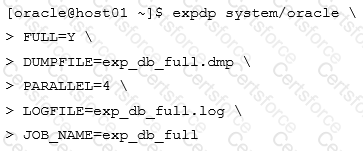Which two statements are true about the WHERE and HAVING clauses in a SELECT statement? (Choose two.)
You execute this command:

During the export operation, you detach from the job by using CTRL+C and then execute this command:
Export> STOP_JOB=immediate
Are you sure you wish to stop the job ([yes]/no): yes
Which two statements are true about the job? (Choose two.)
Which two statements are true about the ORDER BY clause when used with a SQL statement containing a SET operator such as UNION? (Choose two.)
Which three statements are true about using SQL*Plus?
Which three statements are true about undo segments and the use of undo by transactions in an Oracle database instance? (Choose three.)
In one of your databases, the user HR has the password HRMGR.
You want to connect to a database instance whose listener listens on port 1531 by using this statement:
CONNECT HR/HRMGR@orcl
No name server is used.
Which statement is true about ORCL?
You execute this command:

Sufficient storage is available in filesystem /u01.
Which two statements are true about the BIG_TBS tablespace? (Choose two.)
Which two statements are true about date/time functions in a session where NLS_DATE_FORMAT is set to DD-MON-YYYY HH24:MI:SS? (Choose two.)
Which three functions are performed by dispatchers in a shared server configuration? (Choose three.)
Which three statements are true about single-row functions? (Choose three.)